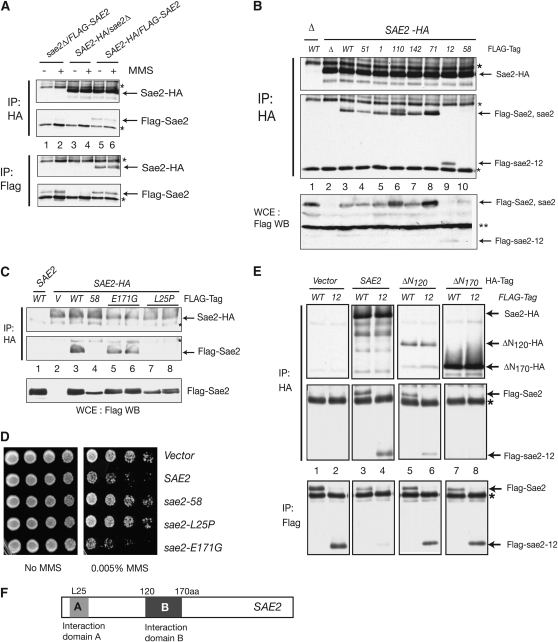Figure 6.—
Sae2 self-interaction via two domains is critical for its cellular functions. (A) Sae2 self-interacts regardless of DNA damage. Interaction between Sae2-HA and Flag-Sae2 was examined in diploid strains carrying integrated SAE2-HA and FLAG-SAE2 by co-IP and Western blot. Cells were either untreated or treated with 0.03% MMS for 2 hr. (B) Sae2 self-interaction is required for its cellular functions. The interaction was examined in diploid strains carrying integrated SAE2-HA and FLAG-sae2 mutants by co-IP and Western blot. (C) Residue L25 is required for the Sae2 self-interaction. The interaction was examined in SAE2-HA strains carrying Flag-sae2 mutant plasmids (2μ). Two independent clones were analyzed for sae2-E171G and sae2-L25P mutants. (D) Residue L25 is required for the inhibition of the TM pathway. rad50S mec1 cells were transformed with either sae2-L25P or sae2-E171G and examined for MMS sensitivity (1/5 dilution). (E) The additional region between 120 and 170 aa is required for the Sae2 interaction. The interaction was examined in FLAG-SAE2 or FLAG-sae2-12 strains carrying the N-terminal truncation sae2 mutant plasmids (2μ). (F) Summary of Sae2 self-interaction domains. Two separate regions are required for the interaction between Sae2, a region containing L25 (domain A, light shading), and a region between 120 and 170 aa (domain B, dark shading). Asterisks (*) indicate antibody heavy and light chains. Double asterisks (**) indicate nonspecific signal.

